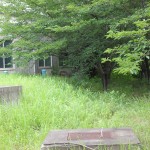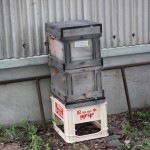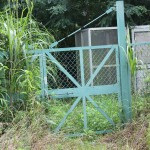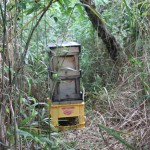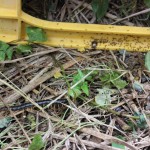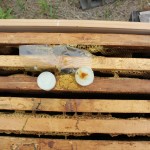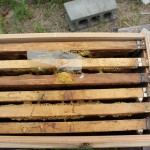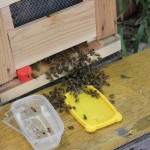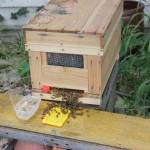On Saturday, May 25, here in Fukuoka, Japan, I checked the bees in the hive I am trying to convert to small cell. To explain, during the past 100 years, honey bees have been “upsized” by various beekeepers and scientists who believed that a larger bee would produce more honey and make them more money. European honey bees that were raised in the U.S. and Europe before this time were smaller, and reared their brood on comb where the cell size that they reared their larvae in was between 4.7 and 4.9 millimeters in diameter. The producers of wax foundation kept gradually increasing the diameter of the preprinted foundation cell pattern until it is the current industry standard of 5.4 millimeters. Those who currently keep their bees on cells that are 4.9 millimeters in diameter or smaller report that they do not need to use any chemicals or treatments to control mites or other secondary diseases or problems, and their winter losses are minimal. I decided to see if I can get the western honey bees at my friend’s house downsized to the 4.9 size foundation.
The first thing I did was to create a “shook swarm” into a hive with frames all with 4.9 foundation. Although low in numbers, that hive is doing well and raising new bees now and drawing out their cells the correct size.
The hive I shook them out of was highly populated and had worker bees of mixed sizes and mixed colors, some dark and some light, so I thought I might be successful in doing the shook swarm. I left the orginal hive in the original location, but found the queen and moved her and as many workers as I could shake off the frames into the new hive with the 4.9 foundation. The original hive was a homemade hive with homemade non-standard size frames, and the spacing of the frames and combs was not good, so the bees were not building up very well and in some places were building a second comb hanging off the first comb on the same frame. They were also raising queen cells, so it looked like they were getting ready to swarm. When I looked at them yesterday, all the queen cells there had been there were torn down and although I did not see the new queen, I assume that there is one because I finally found a small patch of new brood (young larvae and eggs) about the diameter of a grapefruit on one comb. I’m still thinking about what steps I want to take next.
The other hive (which was orignally much smaller and only had a few bees and a queen in it) I had previously transferred into a smaller Langstroth style hive made for Japanese honey bees (with frames with 4.9 foundation), and transferred some of the combs from the original hive into it by cutting them down so they would fit into this smaller hive. I also spaced them closer to the spacing I felt they should have to build smaller cells. I soon noticed that they were reworking the small cell foundation into larger sized cells and not using the 4.9 pattern like I wanted them to. On the other hand, the queen was laying very well and the hive population was growing quickly. I took a rectangular piece of plywood that was the right size for the base of a larger standard size Langstroth hive and cut a hole in the center of it so it would fit over the top of the smaller box and I could put a larger box on top filled with frames with 4.9 foundation. These bees have done exceptionally well and entirely filled the small box and expanded up into the larger box above.
I wanted to find the queen in this hive and move her into the box above and then put a queen excluder between the boxes so the queen would only lay in the box I wanted to move the entire colony into and then I would let the brood in the lower box all emerge and then remove that box from the hive, replacing it with another large box–no longer using the smaller box. Yesterday when I checked them, I was unable to find the queen so I changed my plan. What I did was to move all the bees and frames from the large super into a large bottom box (the hives in Japan have a bottom box with a fixed bottom that cannot be removed) and put it in the location of the original hive. Previously the large super had been on top and the small box on the bottom. I then set the small box aside and went through it carefully frame by frame looking for the queen. I still could not find her (and the bee population is very high with lots of drones, making it very difficult to locate her). I went through all the frames again one by one and still could not find her the second time either, although I did find a capped queen cell and several other queen cups that looked like they were in the process of raising a new queen. It also looked like the bees had backfilled the brood nest with nectar/honey and were in the process of getting ready to swarm, so I decided to make a split.
I left the large box (which already had several combs drawn and being filled with honey and pollen) in the original location and shook and brushed more bees into it (the top was off). I did not use any smoke and the bees were calm and gentle, and when shook into the hive, they did not fly up and try to get back on the comb or into the other box. I shook bees (hopefully most of them were young nurse bees) from several frames with capped brood on them into the large hive and found one small frame in the small box that had small larvae and eggs in it and screwed it into the center of a top bar and placed it into the center of the large hive box in the orignal location, being careful to have all my frames in Housel position. If the queen is in the large box, then everything should be fine. There is a frame of brood coming along and the queen can keep laying. If she is still in the small box, then the bees in the large box can raise a new queen from one of the newly laid eggs or newly hatched larvae. I can check in a week or two and will be able to tell the situation immediately.
I then moved the small box with the capped queen cell already in it into a new location. If the old queen is there, then I will let the bees decide whether they want to keep the old queen or let a new queen supercede her. Most of the capped brood is in this hive, so although the population of adult worker bees is now very small compared to the hive it was split from, there will soon be many new workers emerging and that will not be a problem. It is as though the hive already swarmed. I will be able to tell from what happens in the hive in the original location what the situation is in the small box and then decide what to do there next too. I might end up placing the small hive box back on top of the big hive with a queen excluder between them to combine them. I would not have split them if I had been able to find the queen. So right now I have the potential of ending up with four hives with four laying queens, but I intend to combine and consolidate them back into just two hives if I can find the queens and get them where I want them. I can then get rid of the bad comb and bad frames and boxes and get them all onto small cell foundation, which is my goal. The frames/combs in the small cell boxes are also spaced closer together than the current industry standard. They are at 1-1/4 inches apart which also makes for a tighter brood nest. That is another reason I think the bees in the small box are doing so well.
Next, I went to my office on the Hakozaki campus of Kyushu University and looked at the hives of native Japanese honey bees that I have on the roof of the building. I pulled some frames to look at them. I observed larvae and eggs on the frame I looked at. The bees really did not like to be disturbed, and ran like crazy to the bottom of the frame, and flew off. They were not calm at all, but were really wild, buzzing lound noises and running here and their, shaking their abdomens and threatening me like they would a hornet. It is easy to see how flighty they are and how much more likely they might be to abscond than the European honey bees I was working with this morning. The difference was like night and day.
Finally, I went and looked at a hive of European honey bees that someone else on campus is keeping. The hive they had at the end of last year has died out, and a new hive they established superficially seems to be doing all right. I opened the deadout and could see clearly that the frames were spaced much too far apart, and they tried to feed them with white sugar and pollen substitute. That is probably why they did not survive. They could not cluster to keep warm because the combs were too far apart.
My western bees that are going gangbusters have not been fed anything this year–only what they have found themselves to eat. Another philosophy of the small cell organic beekeepers is to not put anything unnatural into the hive. If the bees need honey to keep from starving, then give them real honey and not sugar syrup. They also need real pollen for the best health. I will report again in a week or two about what I find out and decide to do next with the western honey bees (that is what European honey bees are called in Japan), as well as what I am able to do about moving my native Japanese honey bees off of the hot roof into a shady location where it is cooler. I want to get that done before it really heats up this summer. The monsoon rains are supposed to start in a few days here. They will last about a month and then real summer will be here.




